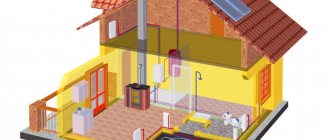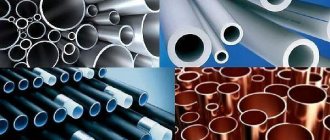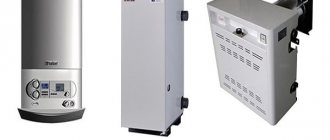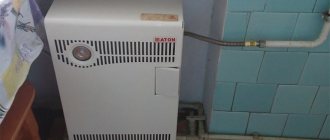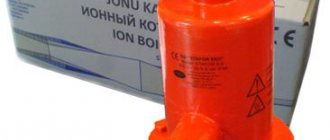Have a nice day!
As you know, the energy efficiency of a heating system depends not only on the power of the boiler and the number of radiators. This is a rather complex parameter, tied to the climate regime of the region, the materials from which the house is built, the quality and quantity of heating equipment and fittings. And heating pipes play the role of one of the “first violins” in the heating system.
What pipe diameter is best to use for heating a private house so that the coolant circulation in the circuit is as efficient as possible? As a rule, special programs are used for this, however, there are alternative concepts that allow you to perform this operation yourself. We will lift the “veil of secrecy” and tell you as simply as possible about complex calculation schemes that allow you to optimize the heating of your home so that it is warm and comfortable without having to throw money away.
The influence of pipe type and size on system performance
Is the pipe diameter really that important? As practice shows, extremely! A number of factors that ensure high efficiency of the entire circuit depend on it:
- Throughput and heat transfer coefficient. Those. the total volume of coolant located in the main during a certain period of time and subject to heating.
- Coolant pressure in the circuit, temperature and speed of its movement.
- Hydraulic losses that occur at the junctions of pipes and elements of different sections. The more such transitions, the greater the losses.
- Noise level of the heating system.
There are several types of diameter:
- External. Takes into account the cross-section of the internal cavity and the thickness of the pipe walls. Used when designing a heating system.
- Interior. Reflects the cross-sectional value of the internal cavity of the pipe. Determines the throughput of the pipeline.
- Nominal (conditional). Represents the average value of internal diameters obtained as a result of calculations.
In order for the heating system to work fully, in addition to the pipe cross-section, a number of other factors should be taken into account:
- Properties of the coolant, which is water, antifreeze or steam.
- The material from which the pipes are made.
- The speed of the coolant.
- Type of heating system: one- or two-pipe.
- Type of circulation: natural or forced.
Where can I get the tables?
Everything is simple here. Usually, all detailed tables with all the necessary data can be viewed (or downloaded) on the websites of pipe manufacturers. But it happens that there are still no tables.
You can get out of this situation as follows. If there are no tables for the outer diameter, then take the one for the inner diameter and calculate according to it. Yes, there will be inaccuracies, but, as experience shows, for forced circulation they are completely insignificant and acceptable.
Having analyzed a huge number of already installed and perfectly working systems, experts noticed a certain pattern in the choice of pipe cross-section. It is mainly suitable for small-sized autonomous systems.
In private houses, the pipes that come out of the boiler are most often one-half and three-quarters in size. This diameter of the pipe for heating a house is used until the first fork, and at each subsequent fork the cross-section is reduced by exactly one step.
But this method is applicable only for apartments and one-story houses; for high-rise buildings, alas, everything will have to be calculated very carefully.
If we have a private house or apartment, autonomous heating for no more than 5-8 radiators and 2-3 forks, we can easily calculate everything ourselves. We need to know how powerful each heating point is, the heat loss in the room and a good table for selecting the pipe diameter.
However, as has already become clear, trust experienced specialists to calculate a complex multi-level system with numerous junctions and forks. Well, if you still decide to do everything yourself, then at least read articles like ours and consult with experts.
Source: eurosantehnik.ru/kak-vybrat-diametr-truby-dlya-otopleniya-doma.html
Pipe material
Before determining which pipe diameter is best suited for heating a private home, it is necessary to decide what material the pipeline itself will be made of. This allows you to determine the installation method, the cost of the project and predict in advance possible heat losses. First of all, pipes are divided into metal and polymer.
Metal
- Steel (black, stainless, galvanized).
They are characterized by excellent strength and resistance to mechanical damage. Service life – at least 15 years (with anti-corrosion treatment up to 50 years).
Operating temperature - 130⁰C. The maximum pressure in the pipe is up to 30 atmospheres. Not flammable. However, they are heavy, difficult to install (special equipment and significant time costs are required), and are susceptible to corrosion. A high heat transfer coefficient increases heat loss even at the stage of transporting the coolant to the radiators. Post-installation painting is required. The internal surface is rough, which provokes the accumulation of deposits inside the system.
Stainless steel does not require painting and is not subject to corrosive processes, which significantly extends the life of the pipes themselves and the heating circuit as a whole.
- Copper.
The maximum temperature of the working environment is 250⁰C. Working pressure – 30 atmospheres or more. Service life – more than 100 years. High resistance to media freezing and corrosion.
The latter imposes restrictions on the combined use of copper with other materials (aluminum, steel, stainless steel); Copper is only compatible with brass. The smoothness of the internal walls prevents the formation of plaque and does not impair the throughput of the pipeline, which reduces hydraulic resistance and makes it possible to use pipes of smaller diameter. Plasticity, light weight and simple connection technology (soldering, fittings). The small thickness of the walls and connecting fittings eliminates hydraulic losses.
The most significant drawback is the extremely high cost; the price of copper pipes is 5-7 times higher than the price of plastic analogues. In addition, the softness of the material makes it vulnerable to mechanical particles (impurities) in the heating system, which, as a result of abrasive friction, lead to wear of the pipes from the inside. To extend the life of copper pipes, it is recommended to equip the system with special filters.
The high thermal conductivity of copper requires the installation of insulating sleeves to prevent heat loss, but it also makes it an indispensable material for underfloor heating systems.
Polymer
They can be polyethylene, polypropylene, metal-plastic. Each modification has its own technical characteristics depending on the production technology, additives used and the specific structure.
Service life – 30 years. Carrier temperature - 95⁰C (short-term - 130⁰C); Excessive heating leads to pipe deformation, reducing service life. They are characterized by insufficient resistance to freezing of the coolant, as a result of which they rupture. The smoothness of the internal coating prevents the formation of plaque, thereby improving the hydrodynamic performance of the pipeline.
The plasticity of the material allows pipes to be laid without cutting, thereby reducing the number of fittings. Plastic does not react with concrete and does not rust, which allows you to hide the heating pipe in the floor and install “warm floors”. A special advantage of plastic pipes is their good sound insulation properties.
When exposed to high temperatures, polyethylene pipes are prone to significant linear expansion, which requires the installation of additional compensation loops and attachment points.
Polypropylene analogues must contain an “anti-diffusion layer” in their structure to prevent airing of the circuit.
The pressure level in the circuit determines not only the diameter of the polymer pipes, but also the wall thickness, which varies in the range from 1.8 to 3 mm. Fitting connections simplify installation of the circuit, but increase hydraulic losses.
When deciding which diameter to choose, you should take into account the specific markings of various pipes:
- plastic and copper are marked by external section;
- steel and metal-plastic - internally;
- often the cross section is indicated in inches; to carry out the calculation they need to be converted into millimeters. 1 inch = 25.4 mm.
To determine the internal diameter of the pipe, knowing the dimensions of the external section and wall thickness, you should subtract twice the wall thickness from the external diameter.
Marking
When choosing polypropylene pipes for repairing home utility networks, attention is drawn to the abbreviation printed on the side, a combination of letters and numbers. This inscription contains complete information about the characteristics of each specific specimen.
Example of PP pipe marking
To decipher the marking and find out the necessary information about the proposed copy, it is recommended that you familiarize yourself in detail with the component contents of the cipher.
Material designation
Information about the manufacturer's brand is contained at the beginning of the inscription. The following letters indicate information about the type of polypropylene pipes:
- PPB. This symbol indicates a PP pipe of increased mechanical strength. The difference between RRV pipes is that the internal cavity is reinforced with fiberglass, a foil coating made of aluminum or copper.
- PPH. These codes designate large-diameter polypropylene pipes. Scope of application: creating water supply lines for cold water and laying ventilation ducts for supply and exhaust ventilation.
- PPR. The main characteristic is to withstand the movement of coolant with a high temperature of up to 70 - 80 degrees, allowing the use of polypropylene water pipes, marked with the letters PRR, for heating and supplying hot fluid.
Although all three varieties are made from polypropylene, they differ in their technical characteristics. The qualitative composition of the polymer mixture is changed by various additives that affect the elasticity of the product.
Maximum working pressure
The letter marking PN with numbers indicates the value of the maximum operating pressure per 1 meter. The value shows the pressure in kg/cm2 and is measured in Bars. Polypropylene pipes are marked with the letters PN25, PN20, PN16, PN10, in which the digital indicator indicates the limit of the nominal pressure of the moving water flow with a temperature of 20 degrees over a long period of 50 years. Based on this definition of the maximum operating pressure, we can conclude that heating and hot water supply are installed only from grades PN25, PN20.
Pipe diameter designation
The marking of polypropylene pipes must include information on outer diameters, measured in mm. The laying of engineering sanitary and heating systems is carried out using PP pipes of various diameters:
- Ф* 20 mm is used for indoor wiring, connecting taps, showers, bathtubs, washing machines and dishwashers.
- Ф* 25 mm is intended for installation of vertical risers of five-story residential buildings..
- F * 32 mm, water supply lines of considerable length and risers of multi-storey buildings are equipped.
- Ф*63 and Ф*100 mm are used in supply lines for centralized water supply.
Ventilation supply and exhaust systems are mounted with propylene pipes with a diameter of 100 to 400 mm. Products of the same diameter are used to organize drainage systems and gutters.
Sometimes on PP pipes there are color markings in the form of blue and red lines. Some brands use these colored stripes to indicate the purpose of the pipe for hot and cold water. For example, PN 20 with a red line is suitable for hot water supply, while PN 10 with a blue line is used for cold water lines.
By the outer diameter you can find out the wall thickness and the maximum pressure for each brand.
Table of values for the ratio of outer and inner diameters, as well as walls
Other indicators
The remaining components of the marking indicate other indicators that complement the technical characteristics of the PP pipe:
- Design.
- Date of issue.
- Batch numbers, shifts, series of production lines.
- Information about the manufacturing standard and the availability of certificates of quality and compliance with GOST.
Some pipe markings may contain additional information.
Optimal size, temperature and pressure
When installing a small heating circuit of a standard type, some recommendations from experts will allow you to do without complex calculations:
- For pipelines with natural circulation of the carrier, it is recommended to use pipes with an internal cross-section of 30-40 mm. Increasing the parameters threatens with unreasonable coolant consumption, a decrease in the speed of its movement and a drop in intra-circuit pressure.
- Too small a pipe diameter will cause an overload inside the line, which can cause it to break through at the connecting elements.
- To ensure the required speed of movement of the coolant and the required pressure inside the forced circulation circuit, preference is given to pipes with a cross-section of no more than 30 mm. The larger the cross-section of the pipe and the longer the line, the more powerful the circulation pump is selected.
Important! Arrangement of an effective heating system involves the use of pipes of different sections in different sections of the main line.
The operating pressure level of the circuit must not exceed the stability limit:
- heat exchanger built into the boiler (max - 3 atm or 0.3 MPa);
- or 0.6 MPa (with a radiator circuit).
The optimal value for heating systems with a circular pump is considered to be in the range from 1.5 to 2.5 atm. Under natural circulation conditions - from 0.7 to 1.5 atm. Exceeding the standard will inevitably cause an accident. To control the pressure level in heating systems, expansion tanks and pressure gauges are installed.
Autonomous heating allows you to regulate the temperature of the coolant yourself, depending on the season and the individual needs of the residents of the house. The optimal temperature is considered to be in the range from 70 to 80⁰C, in steam heating systems – 120-130⁰C. The best solution would be to use gas or electric boilers, which allow you to control and regulate the heating of the circuit, which cannot be said about solid fuel equipment.
The design features of heating systems also determine the temperature conditions:
- the maximum heating of the carrier in a single-circuit wiring is 105⁰C, in a double-circuit wiring - 95⁰C.
- in plastic pipelines the carrier temperature is limited to 95⁰C, in steel pipelines - 130⁰C.
The temperature difference between supply and return is 20⁰C.
Finding relevant data
As for finding the optimal reference data, almost all websites of manufacturers of heating system components provide this information. In cases where suitable values have not been found, there is a special system for selecting diameters. This technique is based on calculations, and not on average patterns based on processing data on a huge number of heating systems. Calculation of the coolant by pipe cross-section was developed by plumbers with practical experience in installation work, and is used for arranging small circuits inside homes.
In the vast majority of cases, heating boilers are equipped with two sizes of supply and return pipes: ¾ and ½ inches. This size is taken as the basis for wiring up to the first branch. In the future, each new branch serves as a reason to reduce the diameter by one position. This method allows you to calculate the cross-section of pipes in an apartment. We are talking about small systems with 3-8 radiators. Typically such circuits consist of two or three lines with 1-2 batteries. Small private cottages can be calculated in a similar way. If there are two or more floors, you have to use reference data.
Boiler and circuit power
The efficiency of the boiler, which plays one of the key roles in the heating system, is affected not only by the diameter of the pipes, but also by:
- type of fuel used;
- location of the boiler (removing the boiler unit outside the house requires increased power, a larger cross-section and insulation of the main line in the outdoor area);
- level of thermal insulation of the external walls of the house;
- use of a heating circuit for hot water supply.
When choosing a boiler, you should take into account the above factors and reserve power by 1.5-2 times.
Rabbits sleep
Watching a sleeping rabbit is a real touch! When animals sleep, their faces and ears are in constant motion. It's funny to us, but in fact, this is an important natural feature. Thus, pets pick up various smells and sounds around them, trying to smell a predator.
It is no less funny and interesting to watch their posture in their sleep. For example, when animals are relaxed and satisfied, they sleep on their tummy or side, stretching out their hind legs. Some people like to sit down when they sleep, covering their face with their ears.
Calculation methods
How to calculate the diameter of heating pipes? There are several methods:
- According to special tables. However, their use still requires preliminary calculations: the power of the heating system, the speed of movement of the coolant, as well as heat loss along the main line.
- By thermal power.
- According to the resistance coefficient.
What you need to know to calculate
To carry out the calculation you will need the following data:
- Heat demand (thermal power) of the entire house and each room separately;
- The total power of the heating devices used (boiler and radiators).
- Thermal load on individual sections of the circuit.
- The total heat loss of the house and each room separately during the coldest winter period.
- Resistance value. It is determined by the wiring diagram, the length of the line, the number and shape of bends, connections, and turns.
- The total volume of coolant loaded into the heating main.
- Flow speed.
- Circulation pump power (for forced heating).
- Line pressure.
Calculation of pipe cross-sections for heating systems with forced air circulation:
Calculation procedure
- Calculation of required thermal power.
- Determination of the circulation rate of the carrier in the heating system.
- Calculation of heating circuit resistance.
- Calculation of the required pipeline cross-section.
- Calculation of the optimal diameter of the heating collector (if necessary).
Calculation of system thermal power
Method 1. The simplest way to calculate thermal power is based on the established standard of 100 watts per 1 m² of room. Those. with a house area of 180 m², the power of the heating circuit will be 18,000 watts or 18 kW (180 × 100 = 18,000).
Method 2. Below is a formula that allows you to adjust the data taking into account the power reserve in case of severe frosts:
However, these methods are characterized by a number of errors, because does not take into account the range of factors influencing heat loss:
- ceiling height, which can vary in the range from 2 to 4 or more meters, which means that the volume of heated rooms, even with the same area, will not be constant.
- the quality of insulation of the house facade and the percentage of heat loss through external walls, doors and windows, floor and roof;
- thermal conductivity of double-glazed windows and materials from which the house is built.
- Climatic conditions of the regions.
Method 3: The method presented below takes into account all the necessary factors.
- The volume of the entire house or each room separately is calculated using the formula:
V = h×S,
Where:
- V – Volume of the heated room.
- h – Ceiling height.
- S – Area of the heated room.
- The total power of the circuit is calculated:
The following formula is often used:
In this case, the regional correction factor is taken from the following table:
The heat loss correction factor (K) directly depends on the thermal insulation of the building. It is customary to use the following average values:
- With minimal thermal insulation (typical wooden or metal structure made of thin sheets), a coefficient in the range from 3 to 4 is taken into account;
- Single brickwork - 2-2.9;
- Average level of insulation (double brickwork) – 1-1.9;
- High-quality thermal insulation of the facade - 0.6-0.9.
Water speed in pipes
The uniformity of the distribution of thermal energy among the elements of the circuit depends on the speed at which the liquid moves, and the smaller the diameter of the pipeline, the faster it moves. There are speed limits:
- not less than 0.25 m/sec, otherwise air pockets will form in the circuit, preventing the movement of the coolant and causing heat loss. If the pressure is insufficient, the air plugs will not reach the installed Mayevsky valves and air vents, which means they will be useless;
- no more than 1.5 m/sec, otherwise the media circulation is accompanied by noise.
The reference flow rate is from 0.36 to 0.7 m/s.
This should be taken into account when choosing the appropriate pipe section. By installing a circulation pump, it becomes possible to control the circulation of coolant in the circuit without increasing the diameter of the pipeline.
Calculation of heating circuit resistance
When calculating the cross-section of pipes using the resistance coefficient, the first step is to determine the pressure in the pipeline:
Then, by substituting the pipe diameters, the minimum heat loss value is selected. Accordingly, the diameter that will satisfy acceptable resistance conditions will be the desired one.
Heating manifold calculation
If the heating system provides for the installation of a distribution manifold, then determining its diameter is based on calculating the cross-sections of the pipelines connected to it:
The distance between the collector pipes should be equal to triple their diameter.
Choosing the diameter for your heating
Do not expect that you will immediately be able to select the correct pipe diameter for heating your home. The fact is that you can achieve the desired efficiency in different ways.
Now in more detail. What is most important in a proper heating system? The most important thing is uniform heating and delivery of liquid to all heating elements (radiators).
In our case, this process is constantly supported by the pump, thanks to which, over a specific time period, the liquid moves through the system. Therefore, we can only choose from two options:
- buy pipes with a large cross-section and, as a result, a low flow rate of coolant;
- or a pipe with a small cross-section, naturally the pressure and speed of the fluid will increase.
Logically, of course, it is better to choose the second option for the diameter of the pipes for heating the house, and for these reasons:
- when laying pipes externally, they will be less noticeable;
- when laying internally (for example, in a wall or under the floor), the grooves in the concrete will be more accurate and easier to chisel;
- the smaller the diameter of the product, the cheaper it is, naturally, which is also important;
- with a smaller pipe cross-section, the total volume of coolant also decreases, thanks to which we save fuel (electricity) and reduce the inertia of the entire system.
And working with a thin pipe is much easier and simpler than with a thick one.
Examples
Let's look at examples.
Calculation for a two-pipe circuit
Given:
- Two-storey house with an area of 340 m².
- The building material is Inkerman stone (natural limestone), characterized by low thermal conductivity. → House insulation coefficient = 1.
- Wall thickness – 40 cm.
- The windows are plastic, single-chamber.
- Heat loss on the 1st floor – 20 kW; the second - 18 kW.
- Two-pipe circuit with a separate wing on each floor.
- Pipe material is polypropylene.
- Serving temperature - 80⁰C.
- Outlet temperature - 60⁰C.
- Temperature delta - 20⁰C.
- Ceiling height – 3 m.
- Region – Crimea (south).
- The average temperature of the five coldest days of winter is (-12⁰C).
Calculation:
- 340×3=1020 (m³) – volume of the room;
- 20- (-12) = 32 (⁰C) – temperature difference (delta) between indoors and outdoors;
- 1020×1×32/860≈38 (kW) – heating circuit power;
- Determination of the pipe cross-section in the first section from the boiler to the branch. According to the table below, pipes with a cross-section of 50, 63 or 75 mm are suitable for transmitting thermal power of 38 kW. The first option is preferable, because provides the highest speed of movement of the carrier.
- To distribute the media flow to the first and second floors, reference books prescribe pipes with a diameter of 32 mm and 40 mm for powers of 18 and 20 kW, respectively.
- On each floor, the circuit is divided into two mains with an equivalent load of 10 and 9 kW, respectively, and a cross-section of 25 mm.
- As the load decreases due to cooling of the coolant, the diameter of the pipes should be reduced to 20 mm (on the first floor - after the second radiator, on the second - after the third).
- Reverse wiring is carried out in the same sequence.
To calculate using the formula D = √354x(0.86xQ/∆t)/V, we take the carrier speed to be 0.6 m/s. We obtain the following data √354x(0.86×38/20)/0.6≈31 mm. This is the nominal diameter of the pipeline. For implementation in practice, it is necessary to select different pipe diameters in different sections of the pipeline, which on average will be reduced to the calculated data according to the algorithm described in paragraphs 4-7.
Determination of pipe diameter for a single-pipe system with forced circulation
As in the previous case, the calculation is made according to the indicated scheme. The only exception is the action of pumping equipment, which increases the speed of movement of the medium and ensures uniformity of its temperature in the circuit.
- A significant reduction in power (up to 8.5 kW) occurs only on the fourth radiator, where the transition to a diameter of 15 mm is made.
- After the fifth radiator there is a transition to a cross section of 12 mm.
Important! The use of pipes made of a different material will make adjustments to the calculation, because... Each material has a different level of thermal conductivity. It is especially important to take into account the heat loss of a metal pipeline.
Equation method
Although pipes made of different materials are marked with different values (internal or external), in some cases they can be equated. This applies to situations where it is not possible to find data on a specific pipe: in such a situation, you can use information on a similar cross-section of a product made of a different material.
Let's say you need to calculate what diameter of a metal-plastic pipe is needed for heating, but the necessary information on this material has not been found. As an alternative, a table of coolant speed in the heating system for polypropylene products is used. Using the appropriate dimensions, the appropriate parameters for the metal-plastic pipe are selected. In this case, it is impossible to avoid inaccuracies, but in forced-type circuits they are not critical.
Features of calculating the cross-section of metal pipes
Heating systems made of metal pipes must take into account the coefficient of heat loss through the walls. This is especially important with a significant pipeline length, when heat loss on each linear meter can have catastrophic consequences for the final radiators.
| Metal | Thermal conductivity coefficient, W/(m×deg) |
| Steel | 45,4 |
| Cast iron | 62,8 |
| Copper | 389,6 |
| Brass | 85,5 |
By adding a power reserve to the power system and choosing the correct pipe diameter, it is possible to prevent significant heat leaks.

